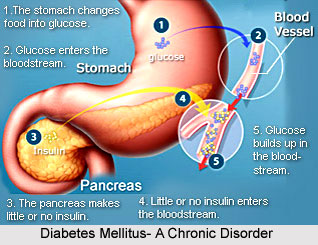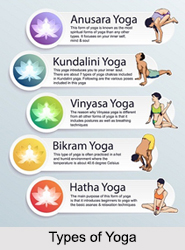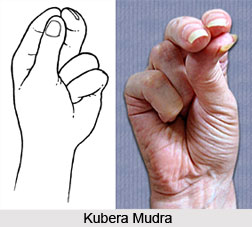 Diabetes mellitus is a chronic disorder of carbohydrate metabolism where glucose is not taken up by the cells of the body from the blood. Glucose provides energy to the cells of all the organs of the body to perform their functions. The entry of glucose into the cell from the blood is helped by insulin, secreted from islets of Langerhans located in pancreas. The cells become ineffective to the presence of circulating insulin in number of people after middle age while certain people have deficiency of insulin secretion because of certain diseases of beta cells of islets of Langerhans. Both these conditions lead to increase of blood sugar in the circulation, which is known as diabetes mellitus. Generally the normal fasting blood sugar range is 80 to 120 mg per 100 ml of blood and post prandial blood sugar after two hours of meals should be up to 140 mg / 100 ml of blood. If an individual`s blood sugar count is not within this range, then the person is considered as diabetic. Diabetes can be controlled through yogic treatments.
Diabetes mellitus is a chronic disorder of carbohydrate metabolism where glucose is not taken up by the cells of the body from the blood. Glucose provides energy to the cells of all the organs of the body to perform their functions. The entry of glucose into the cell from the blood is helped by insulin, secreted from islets of Langerhans located in pancreas. The cells become ineffective to the presence of circulating insulin in number of people after middle age while certain people have deficiency of insulin secretion because of certain diseases of beta cells of islets of Langerhans. Both these conditions lead to increase of blood sugar in the circulation, which is known as diabetes mellitus. Generally the normal fasting blood sugar range is 80 to 120 mg per 100 ml of blood and post prandial blood sugar after two hours of meals should be up to 140 mg / 100 ml of blood. If an individual`s blood sugar count is not within this range, then the person is considered as diabetic. Diabetes can be controlled through yogic treatments.
Diabetes is classified in to Insulin Dependent Diabetes Mellitus (1DDM) or type I and Non Insulin Dependent Diabetes Mellitus (NIDDM) or type II diabetes. If diabetes occurs in childhood it is known as Juvenile diabetes. Diabetes found in middle-aged people is known as Maturity onset diabetes. Other conditions, such as, heredity, obesity, mental and emotional stress and strain, prolonged anxiety and conflict, sedentary lifestyle, lack of exercise and wrong food habits are also responsible of causing diabetes. This ailment is often characterised by frequent urination, excessive thirst, extreme hunger, increased fatigue, abnormal weight loss, irritability and blurry vision. Diabetes at its initial stage can be treated with regular exercise, insulin shots, daily aspirin intake and blood pressure and cholesterol control.
Proper exercise, diet control, hygienic measures, like, taking gargles and skin care will keep majority of the symptoms of diabetes under control. Insulin injection is required for patients whose endogenous insulin secretion is deficient due to destruction of beta cells of islets of Langerhans. In yogic treatment consisting of relaxative asanas and the advice to change the outlook in our day-to-day life bring about control of sugar. Along with the well-balanced diet, medicine and a few exercises, necessary corrections in lifestyle and the following yoga practices will help the patients to manage the disorder successfully. Patient should be educated about the overall situation and convinced that the treatment will have to be continued for rest of the life.
Yoga asanas are quite beneficial in the treatment of diabetes. Due to various twists, stretches and strains in the body, the internal organs are stretched and undergo strain. The increases the blood and oxygen supply to the major organs, thus, increasing the efficiency and functioning of the organ. The yoga asanas stretch various glands and result in increased efficiency of the endocrine system. There is reduction in blood sugar due to muscular exercise performed in the asanas. The best time for performing yogic asanas is early mornings and evenings. Strengthening the immune system is also vital since some illnesses can cause the body to produce more blood sugar. Food and alcohol also has great effects on the blood sugar level. Alcohol intake can make the sugar level to fall while food intake can raise it up, so one should drink only in moderation. The level of estrogen and progesterone in the body also cause changes in the blood sugar level, especially during the third week of the menstrual cycle.
Some of the Yoga asanas that should be followed in order to check diabetes is as follows
Sun Salutation is a very good exercise for people suffering from diabetes because it increases the blood supply to various parts of body and thus improves insulin administration in the body. All the benefits of exercise can be achieved if four rounds are practiced in every minute.
 Paschimottanasana or the Posterior Stretching pose is a very good stretching exercise in which the posterior muscles are stretched and relaxed. The main advantages of this exercise include calming of the brain and helping to relieve stress, stretching the spine and shoulders. Improving digestion, this asana helps the Diabetic patients by stimulating the liver, kidneys, ovaries and uterus; it also soothes headache and anxiety and reduces fatigue. This exercise also increases appetite, reduces obesity and control diabetes.
Paschimottanasana or the Posterior Stretching pose is a very good stretching exercise in which the posterior muscles are stretched and relaxed. The main advantages of this exercise include calming of the brain and helping to relieve stress, stretching the spine and shoulders. Improving digestion, this asana helps the Diabetic patients by stimulating the liver, kidneys, ovaries and uterus; it also soothes headache and anxiety and reduces fatigue. This exercise also increases appetite, reduces obesity and control diabetes.
Jalaneti is a very effective method for providing relief from diabetes, allergies, common cold and even asthma. Jalanet is in a form of saline nasal irrigation, which helps thousands of people to relieve from sinus infection. It clears away the impurities in nasal passage. Patients should perform, Jalaneti only in the morning.
Kapalbhati is a power-breathing technique that helps to control the negative effects of diabetes. It is the only technique used particularly for mind purification among all the yoga cleansing exercises. Regular practice of this exercise, once or twice a day will truly give amazing results.
Anuloma-Viloma is also known as Nadishudhan pranayama and it is a process of purification. It helps the human body to get rid off the toxins that have built up through stress and pollution. It also helps to control the effects of diabetes, cure cough and colds, insomnia, chronic headaches and asthma. Anuloma Viloma restores, equalizes and gradually balances the flow of prana in the body.
Vajrasana is regarded as the king of all asana related with the mind and body. Vajrasana series asanas are mostly recommended in therapeutic yoga. Vajrasana series plays an important role in alleviating waist pain, spinal chord or shoulder pain. These are also quite effective during menstrual disorders and abortions like problems or even normal delivery. During vajrasana the vital energy flow is towards sahsradhara from muladhara, which helps in meditation.
Savasana is an excellent posture that can be used between poses that allows total relaxation. This exercise helps to lower high blood pressure, relieves physical fatigue and mental tension. It brings about relaxation, peace and tranquility. It if particularly beneficial for people suffering from diabetes anxiety, worry and mental tension are some of the main causes of the disease. It stimulates blood circulation and exercises inner organs.
Ardha matsyendrasana is basically the exercises of vertebrae and helps in keeping them in good shape. It also helps the liver, spleen, bladder, pancreas, intestines and other abdominal organs. Other than diabetes, it is beneficial in the treatment of obesity, dyspepsia and asthma.
Besides these yoga poses, such as, Bhujangasana, Salabhasana, Dhanurasana, Naukasana, Pavana muktasana, Ustrasana, Vrikshasana, Vakrasana, Sarvangasana or Viparita karani, Matsyasana and Halasana also help in treating diabetes.
Pranayama is the breathing process or the control of the motion of inhalation, exhalation and the preservation of vital energy. Bhasrika Pranayama is revitalizing Pranayama, which increases oxygen levels and reduces carbon dioxide levels in the blood.
Shankha Prakshalana is recommended for diabetes. Complete Shankha Prakshalana takes one day and is recommended once in 6 months, but beginner`s version of it can be done 3 months a week.
 Practice of meditation is especially useful in management of diabetes. Initially meditation may be difficult, and the beginner can practice Omkar chanting and concentration on breathing. Especially for diabetes, concentration on pancreas during the meditation practice has shown affirmative effects on sugar levels. One can even feel the proper functioning of pancreas, proper insulin administration in the body that can help in treatment of diabetes. Yoga Nidra is very important process of deep relaxation; it helps in eliminating the stress and has very good positive effects on the entire body-mind complex, especially for diabetes patients.
Practice of meditation is especially useful in management of diabetes. Initially meditation may be difficult, and the beginner can practice Omkar chanting and concentration on breathing. Especially for diabetes, concentration on pancreas during the meditation practice has shown affirmative effects on sugar levels. One can even feel the proper functioning of pancreas, proper insulin administration in the body that can help in treatment of diabetes. Yoga Nidra is very important process of deep relaxation; it helps in eliminating the stress and has very good positive effects on the entire body-mind complex, especially for diabetes patients.
In terms of precautionary measures a person suffering from diabetes should try to remain mentally relaxed throughout the day. He or she must avoid high calorie carbohydrates or oily foods; instead they should consume protein rich diet. Moderate exercises and regular practice of yoga is the key to keep the blood sugar count in control. Frequent monitoring of blood glucose level and adjustment of the medicinal dosages should be done as per the doctor`s advice as well.
DISCLAIMER - Yoga asanas prescribed above should be strictly performed under the supervision of an experienced Yoga teacher.




















